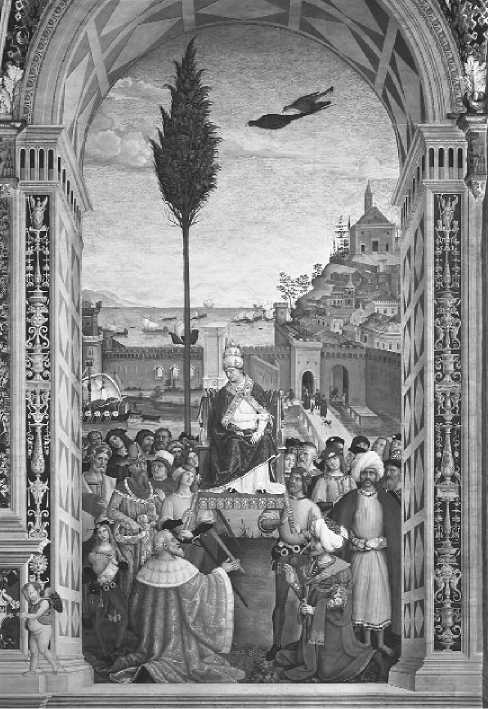Humanist, pope (1458-1464), and propagandist of a crusade against the Ottoman Turks.
Enea Silvio (Latinized as Aeneas Silvius) Piccolomini was born at Corsignano on 18 October 1405 into an Italian noble family. He trained as a jurist, attended the Council of Basel (1432-1442), and later entered the service of Frederick III, king of the Romans. After his ordination (1446), a stupendous ecclesiastical career elevated Aeneas to the bishopric of Siena (1450), the cardinalate (1456), and, finally, to the papacy. He was elected in 1458 as successor to Pope Calix-tus III, taking the name Pius II. Ever since the fall of Constantinople (mod. Istanbul, Turkey) to the Ottomans (29 May 1453), he had propagated a crusade against the Turks, both as a diplomat and a rhetorician. From 1458 it became the foremost issue of Pius’s pontificate. In 1459-1460 he summoned the Congress of Mantua, trying, though with little success, to inaugurate a common European alliance against Turkish aggression. In the crusading bull Ezechielis (23 September 1463) Pius promised to participate in the expedition personally, but on his way to Ancona, where a fleet already lay at anchor, he died on 15 August 1464.
In his famous Latin letters and speeches at the diets in Regensburg (1454) and Frankfurt am Main (1454) and at Mantua, which soon became models of their genre, he evoked the examples of Pope Urban II’s sermon at the

Pius II arrives at Ancona and calls forth the Crusade, by Pinturrichio (1454-1513). (Scala/Art Resource)
Council of Clermont (1095) and the First Crusade (1096-1099). He made extensive use of the chronicle of Robert of Rheims as well as of Bernard of Clairvaux’s letter of exhortation, blending them with humanist style and thought. Besides advocating the military option, Pius addressed a letter to the conqueror of Constantinople, Sultan Mehmed II (Epistola ad Mahumetem, 1461), advising him to adopt Christianity and thus become a second Constantine. In 1458 he composed an epitome of the Histori-arum decades of Flavio Biondo (1392-1463), which comprised an account of the First Crusade.
-Peter Orth
Bibliography
Abulafia, David, “Ferrante I of Naples, Pope Pius II and the Congress of Mantua (1459),” in Montjoie: Studies in Crusade History in Honour of Hans Eberhard Mayer, ed.
Benjamin Z. Kedar, Jonathan Riley-Smith, and Rudolf Hiestand (Aldershot, UK: Variorum, 1997), pp. 235-249.
Bisaha, Nancy, “Pope Pius II’s Letter to Sultan Mehmed II: A Reexamination,” Crusades 1 (2002), 183-199.
D’Ascia, Luca, Il Corano e la tiara: L’Epistola a Maometto II di Enea Silvio Piccolomini (papa Pio II); Introduzione ed edizione (Bologna: Pendragon, 2001).
Helmrath, Johannes, “Pius II. und die Turken,” in Europa und die Turken in der Renaissance, ed. Bodo Guthmuller und Wilhelm Kuhlmann (Tubingen: Niemeyer, 2000), pp. 79-137.
Mitchell, Rosamond J., The Laurels and the Tiara: Pope Pius II, 1458-1464 (London: Harvill, 1962).
Orth, Peter, “Papst Urbans II. Kreuzzugsrede in Clermont bei lateinischen Schriftstehern des 15. und 16. Jahrhunderts,” in Jerusalem im Hoch - und Spdtmittelalter: Vorstellungen und Vergegenwdrtigungen, Konflikte und Konfliktregelung, ed. Dieter Bauer, Klaus Herbers, and Nikolas Jaspert (Frankfurt am Main: Campus, 2001), pp. 367-405.
Pii II commentarii rerum memorabilium que temporibus suis contigerunt, ed. Adrianus van Heck, 2 vols. (Citta del Vaticano: Biblioteca Apostolica Vaticana, 1984).
Pius II, Papa, Epistola ad Mahumetem, ed. and trans.
Reinhold F. Glei and Markus Kohler (Trier: Wissenschaftlicher Verlag, 2001).
Pius II, “elpiu expeditivo pontefice”: Selected Studies on Aeneas Silvius Piccolomini (1405-1464), ed. Zweder von Martels and Arjo Vanderjagt (Boston: Brill, 2003).




 World History
World History









